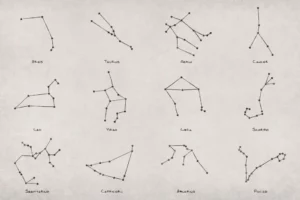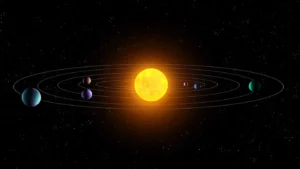
A Guide to Astronomy Binoculars
Newcomers to astronomy often rush to buy the first telescope they see in a department store, and this is perfectly understandable. All the beautiful pictures of celestial objects seen in magazines or in books have this effect on most people.
Unfortunately, after setting the telescope in the backyard and taking the first look at the night sky all the magic is gone. The instrument’s narrow field of view and confusing image orientation will soon cause more frustration than fun.
The obvious alternative is to invest in binoculars, which have the advantages of being relatively inexpensive, highly portable and easy to use. The only disadvantage is that the magnification is generally fixed. Zoom models with variable magnification are also available, but for reasons you will find later in this article, it is probably better to accept the fixed-power limitation.
Binoculars magnifying 5 to 8 times are ideal for finding the planets, scanning Milky Way star fields, studying star clusters such as the Pleiades and Hyades, and viewing bright comets. The Moon will also prove a constant source of enjoyment; the mountains, valleys and craters are beautifully brought out, and it takes only a few minutes to learn the most prominent features.
How Binoculars Work
To understand the working principle of binoculars, first you need to know a little about telescopes. In fact, this is exactly what binoculars are, two identical telescopes placed next to each other.
At the front of each telescope is a lens, called the objective. Its role is to gather light from whatever it is you’re looking at and bring it to a focus in the eyepiece, where the light is formed into a visible image and magnified to take up a large portion of the retina. The magnification depends on the focal length of the eyepiece, and for binoculars, it is usually between 5x and 10x.
The image produced by this telescope will be upside down and backward, but for astronomical viewing, this is not a major inconvenience. In space, there is no up and down or left and right. However, for watching birds or following the action at a baseball game a right-side-up picture is essential. This is why binoculars use corrective elements between the objective and the eyepiece, called prisms.
Prisms used in binoculars are blocks of glass that function as mirrors but without a mirror’s reflective backing. They come in two models and use different types of glass, and we will discuss about this later in the article. For now, let’s just mention their role, which is to bring the light beams from the objective closer together by means of internal reflection, and also turn the image right-side up and orient the view properly from left to right.
To better understand the working principles take a look at the image above. It shows the path of the light as it enters the objectives, passes through a set of prisms that turn the image right side up, and finally leaves the eyepieces to enter the observer’s eyes. This applies to all binoculars, no matter what model or size.
Magnification
All binoculars are described by using a pair of numbers, such as 7×50 or 8×30. The first number, including the x, represents magnification or “power”. This tells the degree to which the object observed is enlarged. For example, a 7x binocular makes an object appear seven times closer than when viewed by the naked eye.
There are some models of binoculars that offer variable magnification, usually in the range of 5x to 8x. They are called zoom binoculars, and in most cases are not very suited for astronomical observations because of the inferior optical quality and fragile mechanics. The best thing to do is to avoid them and stick with the usual fixed-power binoculars.
Magnification is not that important, and in most cases comes within 7x to 12x. If the magnification exceeds these figures, most likely you won’t be able to hold the binoculars steady enough and the images will be blurry and in constant movement. This is especially frustrating when observing faint objects like galaxies and nebulae. A tripod mount or image-stabilized binoculars will get you rid of this problem, but we will talk about this later in the article.
Aperture
The second number in the two-number code is aperture (from the Latin aperire – “to open”), the most important specification of binoculars if you plan to use them for astronomical observations. It represents the diameter of each of the objective lenses (the lenses furthest from your eye), given in millimetres. Therefore, 7×50 binoculars have objective lenses 50 mm in diameter.
The aperture is so important because it determines the light-gathering ability of your binoculars. Most celestial objects glow very dimly, so a large aperture becomes much more important in low-light conditions. For example, 35 mm binoculars will do great when you watch a baseball game on a sunny day, but when used to observe the night sky you will find that they are pretty useless compared to typical 50 mm binoculars.
The 15 millimetres difference in lens diameter does not sound that huge, but we need to compare the surface area, not the diameter. The area of a circle is proportional to the length of the diameter times itself, so a small increase in diameter makes a big difference in area. This is why our 7×50 binocular has twice the light-gathering ability of the 7×35 binocular.
After all, these said, it is clear that when it comes to aperture bigger is better. The larger the light-gathering area, the brighter the images will appear. Compared to the naked eye a 50 mm binocular gathers from 50 to 100 times as much light, translating into a difference of five stellar magnitudes. Therefore, if from your observing site, you can see stars to magnitude 5.5 with the naked eye, the binocular will show many more stars down to magnitude 9.5 or even dimmer.
Exit Pupil
If you divide the objective lens diameter by the magnification, you will get a number approximately between 4 and 8. This number is called the exit pupil and represents the diameter of the beam of light that leaves the eyepiece when you hold a binocular with the objective pointed towards a light source. For example, a 7×50 binocular has an exit pupil of 50 divided by 7, just over 7 millimetres in diameter.
Ideally, the exit pupil of your binoculars should be equal to or slightly smaller than the pupil of your dark-adapted eye. In this way, the binocular delivers the maximum amount of light and produces the brightest possible images for its aperture.
Average young adults under dark night conditions have pupils that are open to about 7 millimetres. This means that any instrument with an exit pupil larger than 7 millimetres will only waste light, as only the centre of the light beam could enter the eyes. As we get older our eyes dilate less, so the exit pupil size we need decreases to around 5 millimeters.
Field of View
The field of view is the area of sky or land seen through your binoculars, determined by the design of the instrument’s optics. It is expressed in two ways; as the width in feet at 1,000 yards, or in degrees of field. When expressed in feet the field is called linear, and when expressed in degrees it is called angular. Don’t let the terms confuse you, the conversion is easy – divide the liner field by 52.35 and you get the angular field.
In most cases, the field is indicated on the outside of the binocular, in degrees. Average values are between 5 and 10 degrees, or roughly 260 to 520 feet. To get an actual idea of how wide this field is, think that in five degrees you can fit almost 10 Full Moon diameters!
For astronomy, a wide field of view is desirable because if offers a more pleasant viewing experience, and you can see more of the sky at a better edge performance compared to a narrower field. However, when increasing the field beyond a certain point images start to exhibit signs of distortion, especially near the edges of the field. Also remember that the field of view is related to magnification; the higher the power of your binoculars, the smaller the field will be.
Eye Relief
Eye relief is the distance behind the eyepiece lenses at which the image is in focus, and indicates how far the binoculars can be held from your eyes and still allow you to see the entire apparent field of view. In general, the longer the focal length of an eyepiece, the greater is the eye relief. Standard binoculars have eye relief ranging from only a few millimeters to 25 millimeters or more.
Long eye relief is especially necessary for eyeglass wearers because glasses increase the distance between the lens and your eye. In case your eyeglasses are correct only for near or farsightedness, you can simply take them off and refocus the binocular to compensate.
Interpupillary Distance
The interpupillary distance is the distance between each of the adult person’s eyes. Most binoculars are adjustable to accommodate different interpupillary distances, typically within a range of 60 mm to 72 mm. Many children and some women have interpupillary distances too short for standard binoculars, so the only solution is to choose compact binoculars.
Antireflection Coatings
Because when using binoculars to observe the night sky you want the biggest possible amount of light to reach your eyes and not be reflected back into space from the objectives, modern lenses have antireflection optical coatings on at least one of the air-to-glass surfaces. Very good models will have all glass surfaces coated but tend to be more expensive.
The most used and least expensive coating is a single layer of magnesium fluoride (MgF), but there are also modern broadband multi-coatings. To save money, some optics manufacturers coat only some of the air-to-glass surfaces, and basically, we can talk about four levels of coatings used on binoculars.
Coated lenses are the lowest quality, with a single-layer MgF coating on some of the optical surfaces. Fully coated means that all air-to-glass surfaces are coated with a single-layer MgF coating. Multicoated lenses have multi-layer coatings applied on some surfaces, and finally, fully multicoated lenses have multi-layer coatings applied to all of the surfaces.
Recently the market has been invaded with binoculars that have so-called “ruby” coatings intended to reduce glare in bright light and improve the contrast between brown and green objects. Avoid any binocular that uses these coatings, they will perform poorly for astronomical use.
Prisms
All binoculars are built with prisms that serve as mirrors to reflect the incoming light between the widely spaced objectives and the narrowly spaced eyepieces. They also have the role of inverting the image that the objective lenses project, in a right-side-up and not reversed left-to-right view. Prisms come in two types: roof and porro prisms.
Roof prisms are in line inside the optical tubes, allowing binoculars to be made small and light. This is a great advantage for hikers and birders, but for astronomical use, roof-prism binoculars prove to be poor performers.
In roof prism binocular design the light beam is split in two parts, then recombined. This process leads to “phase shifting”, meaning that less light is transmitted in the eyepiece and contrast is decreased. Besides, roof-prism binoculars are generally much more expensive than porro-prism binoculars of equal quality.
Porro-prism binoculars align the objective lenses and eyepieces in an offset arrangement, with the objective lenses farther apart than the eyepieces. They offer a wide field of view and are very affordable. However, porro prisms have a minor drawback: they are easier to knock out of alignment than roof prisms.
Prisms are made of two types of glass, BK-7 borosilicate flint glass and BaK-4 barium crown glass. For most designs, prisms made of BaK-4 are preferred over the standard BK-7 because they have a higher refractive index and give brighter and well-defined images.
To check for yourself the type of prisms in your binocular, hold it pointed towards a light source and take a look at the exit pupils. If the prisms are made of BaK-4 glass the exit pupils will be round and evenly illuminated. If the prisms are of BK-7 glass you will notice squarish, grey edges in the exit pupils.
Focusing Mechanism
Binoculars come with two types of focusing mechanisms. Most people opt for the centre-focus model, which uses a centrally mounted wheel to adjust both eyepieces at once. There is also a separate adjustment for the right eyepiece, which helps to correct for any difference in near or farsightedness between your eyes.
Because focusing requires only one quick adjustment, this model is the most popular, and best suited if you want to use your binoculars for other purposes except astronomy.
The second focusing system uses individually focused eyepieces and has no centrally located focusing mechanism. Even though focusing is slower compared to the previous model, binoculars that use individual focus tend to be more rugged and less prone to moisture infiltrations.
These models are the the best choice if you plan to use your binoculars for night sky observation because celestial objects don’t change their distance and frequent refocusing is not required.
Waterproofing
Because cleaning binoculars can be very expensive, you might consider buying waterproof models. They are designed to resist repeated changes in temperature and humidity, making it impossible for condensation to damage internal parts of the instrument. While waterproofing might not seem very useful for astronomy, it is a must if you plan to use your binoculars for boating, hunting, hiking, or other outdoor uses.
Baffling
Baffling within the binocular has the role of shielding against stray light and internal reflections, and can dramatically improve image contrast. To check if your binocular has quality internal baffling, point it at a bright surface and examine the field of view. It should be surrounded by a black background, without additional light or shiny reflections.
Collimation
Because binoculars are basically two small telescopes mounted side by side, an error in collimation (optical and mechanical alignment) can lead to numerous problems including eyestrain and double images.
Most cheap binoculars are shipped out from the factory with collimation problems, and even quality models come out of alignment as they age and get bumped around. The only solution to this problem is to buy binoculars with quality mechanics, which will last longer before collimation errors become a nuisance.
Stabilizing the View
For any binoculars to give their best, they need to be held steady. This eliminates the constant jiggling associated with hand-holding and allows you to see small details and objects fainter than you might think possible.
The traditional and least expensive mount for binoculars is a simple camera tripod. Most binoculars come with a threaded mounting hole and an L-shaped adapter that screws into this hole and onto the tripod. If you don’t receive the adapter when you buy your binoculars you can purchase it separately, or even make your own.
Unfortunately, this type of mounting is difficult to use and tiring for the neck, especially when observing objects near the zenith. The solution is to purchase a commercial mount specially designed for astronomical use or go for image-stabilized binoculars if your budget allows it.
Image-stabilized binoculars have an active built-in optical system that compensates for the movement associated with hand-holding. All you need to do is press a button on the top of the binocular housing, and you will get tripod-like stability with the convenience of hand-holding. The only drawbacks of these models are their small apertures, and prices several times greater than their nonstabilized equivalents.
Test Before You Buy
When you buy binoculars you should check their performance at the store, or if you buy them online, as soon as they arrive. Here are a few tests that will help you choose a quality binocular.
1. Look carefully at the objective lenses. Reject the binoculars if you see signs of scratches or dirt.
2. Consider the weight and bulk of the instrument; lightweight binoculars are less tiring to hold than heavier ones.
3. Is the instrument soundly made? Pick it up and move the halves back and forth. The hinge should work smoothly, with steady resistance. If there is any play in the joints or anything rattles put it back and try another.
4. Hold the binoculars at arm’s length away from you, and point them at the sky or a window. The exit pupils should be truly circular and uniformly bright.
5. For most binoculars collimation problems are not immediately obvious when you first pick the instrument up and view through it. If after using the binoculars for several minutes your eyes feel uncomfortable as they compensate for the barrel misalignment, most probably the binoculars are out of collimation, which means that the two barrels don’t point in the same direction. This is a serious problem, and you shouldn’t buy those binoculars.
6. Look through the binoculars, find a high-contrast object such as a tree against the daytime sky, and place it in the center of the field. If you see strong green or violet fringes of light along the edges of the object, the binoculars suffer from a defect known as chromatic aberration. In general, the higher the magnification, the bigger the chromatic aberration. This error is not critical for astronomical use, but it can be a real problem for birders and other nature enthusiasts that want accurate color rendition.
7. Check the type of antireflection coatings by looking at the two reflections of the light from the front and back of the objective lenses. Multicoated lenses usually give green or purple reflections, while simple coated lenses generally have blue reflections. Don’t buy binoculars that give bright white reflections; they have no antireflection coatings and will perform poorly for astronomical use.
8. If you choose binoculars with large fields of view, you might notice that the edges of the field are conspicuously distorted. This optical defect is called distortion and is most obvious during daytime use. Even high-quality binoculars have some degree of distortion, but it is hardly noticeable, especially in astronomical viewing.
9. The ultimate test for your binoculars is to take them outside at night and look at a bright star. After you have the star centered in the field of view and bring the binoculars in good focus, take a close look at it. The star should be a sharp near-pointlike imagery, without any irregular spikes or rays shooting out of it. Small deviations from this ideal image are always present to some degree in most binoculars, and this is perfectly OK as long as the star remains a round disk, even when moved towards the edge of the field.
One last word: Remember that you always get what you pay for. In most cases the brand name tells a lot about the quality of the instrument, so avoid buying from companies with which you are unfamiliar. Brands like Nikon, Minolta, Leica, Leupold, Bausch and Lomb, Tasco, and Bushnell have a reputation for high-quality standards, even for inexpensive models.

Emil, an avid astronomy writer, formerly owned and ran nightskyinfo.com, making the universe more comprehensible for his readers. He has recently handed over its reins to Tom Urbain from starlust.org, ensuring that his legacy of simplifying the stars continues to enlighten and inspire.
Learn to navigate the night sky 🔭
This page is part of our collection of stargazing articles. If you enjoyed the read, then you’ll love the following articles.




